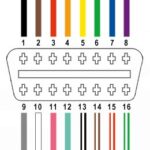Are you looking to bring modern diagnostic capabilities to your older Nissan vehicle? Many enthusiasts are curious about using readily available OBD2 tools and smartphone apps with their classic Nissan models, which often feature the 14-pin Consult port. This exploration leads us to the crucial piece of hardware: the 14 Pin To 16 Pin Obd2 Connector Adapter For Nissan.
The appeal is clear: imagine using your Android phone with popular apps like Torque Pro, OBDlink, or Scanmaster to monitor your Nissan’s engine parameters, read fault codes, and even datalog performance – functionalities readily available for OBD2 compliant vehicles. The core question is whether a simple adapter can bridge the gap between Nissan’s older 14-pin Consult port and the modern 16-pin OBD2 standard.
While OBD2 is widespread in modern cars, Nissan, in its older models, utilized a proprietary protocol known as DDL through its 14-pin Consult port. This means direct compatibility with standard OBD2 apps and tools is not guaranteed. The challenge lies in whether these generic apps can effectively communicate with the Nissan ECU via an adapter, or if Nissan-specific software is required.
Solutions like the ConsultBT: Nissan Consult Bluetooth Adapter suggest that bridging this gap is indeed possible. These devices often integrate both the adapter functionality and the necessary communication protocols to translate Nissan’s DDL to something understandable by OBD2 tools or Bluetooth interfaces.
Another interesting avenue is using a 14 pin to 16 pin OBD2 connector adapter in conjunction with a generic, inexpensive OBD2 (VAG-COM 409) USB cable. This setup, while not OBD2 compliant in the standard sense, can work with Nissan-specific software on a Windows laptop. This offers a cost-effective alternative to dedicated Consult cables, especially for users comfortable with laptop-based diagnostics and Nissan-specific software.
In conclusion, the 14 pin to 16 pin OBD2 connector adapter for Nissan opens up intriguing possibilities for diagnosing and monitoring older Nissan vehicles with modern tools. While direct plug-and-play compatibility with all OBD2 apps isn’t assured due to Nissan’s DDL protocol, solutions and workarounds exist, offering varying levels of functionality and compatibility. Further exploration and testing are key to fully unlocking the diagnostic potential for classic Nissans.
